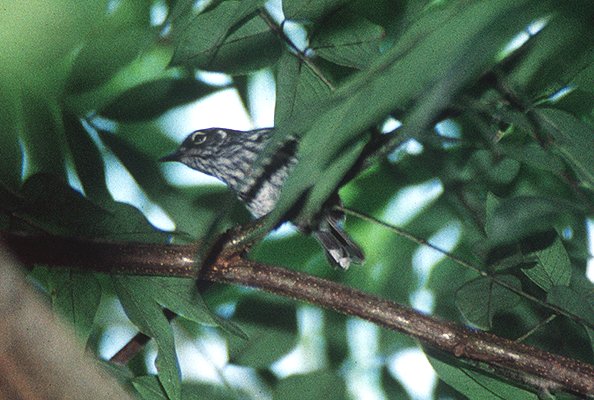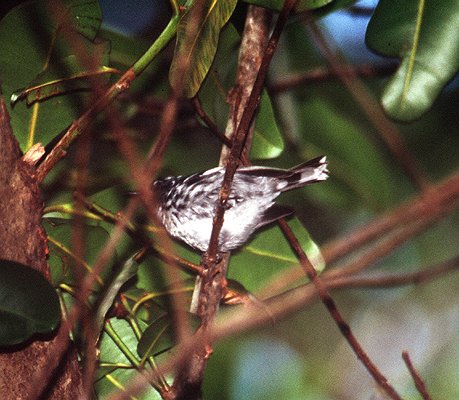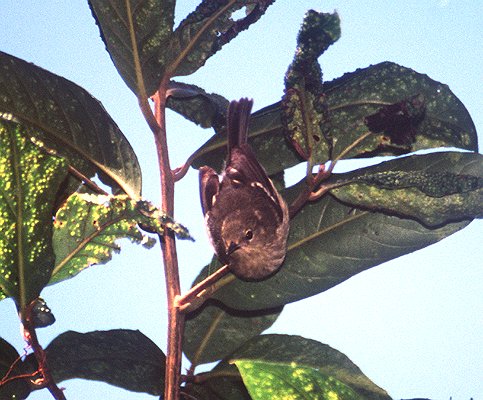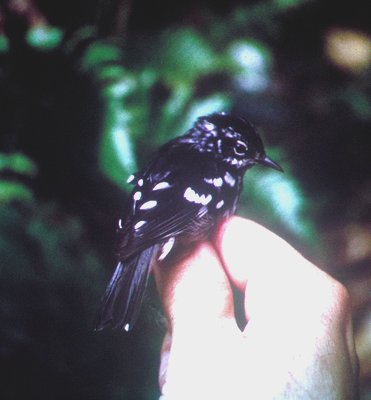|
Elfin-woods Warbler Dendroica angelae Reinita de Bosque Enano
|
 |
|
Photo: G. Beaton
|
|
Elfin-woods Warbler Dendroica angelae Reinita de Bosque Enano
|
 |
|
Photo: G. Beaton
|
|
IDENTIFICATION: This warbler is black above, with a large black "cheek" patch, white facial markings, and two white wing bars. The underparts are white, with black streaks from the throat to the belly. The black tail has white spots on the underside. The bill is longer and the wings more rounded than in many species of migratory warblers that breed in North America, a general pattern among Caribbean endemic warblers known as the "island phenomenon." Length: 12 cm.; weight: 8.4 g. VOICE: The song is a galloping series of dry, tick notes. Call is a sharp, buzzy note. Audio 2 (M. Oberle). In the audio clip of the Warbler's song, a loud Puerto Rican Vireo is also singing. HABITAT: Mountain cloud forest and lower montane forest from 370-1030 meters in elevation. HABITS: This warbler is often seen only briefly as it rapidly gleans insects from branches and leaves, rarely staying in one location for more than a few seconds. It sometimes hovers to glean an insect off a leaf, or rarely catches an insect in mid-air. In dwarf forest it forages just below the canopy, often in tangles of vines. In taller forest, it prefers middle levels of the forest. It often travels in mixed-species flocks including Lesser Antillean Pewee, American Redstart, and Puerto Rican Tanager. Both sexes make a cup nest in a tangle of vines or clump of leaves in the canopy, sometimes with a Cecropia leaf as protective cover. Two or three eggs are laid in April. Because of its very restricted range, dense habitat, and superficial resemblance to the migratory Black-and-white Warbler, this endemic species was not discovered until May 1972. Drs. Cameron and Angela K. Kepler were working in El Yunque on other species when they discovered the Elfin-woods Warbler. STATUS AND CONSERVATION: Currently a rare permanent resident that was initially thought to be restricted to high altitude, dwarf forests. But it was subsequently found to be commoner in taller forest, at slightly lower elevations. This suggests that it may have been more widespread, but survived on high ridges during Puerto Rico’s bottleneck of deforestation in the early 20th Century. Although the warbler’s habitat is occasionally threatened by the construction of communications antennae and roads, most of its habitat is in protected public forests. Hurricanes periodically defoliate trees at high elevation, but both the forest ecosystem and the warbler have adapted to these storms. RANGE: Endemic to Puerto Rico, this species is found only in higher forests and ridges in the Sierra de Luquillo (El Yunque), Sierra de Cayey, and the Cordillera Central at Toro Negro and Maricao State Forests. Regular locations to find this species are along PR 120, in Maricao Forest at Km 18.9 and near the picnic area at Km 16.2. TAXONOMY: PASSERIFORMES; PARULIDAE. Three related species of warblers are endemic to other Caribbean islands: the Arrow-headed Warbler of Jamaica (Dendroica pharetra), the Plumbeous Warbler of Guadeloupe and Dominica (Dendroica plumbea), and the Whistling Warbler of St. Vincent (Catharopeza bishopi). The Arrow-headed Warbler is most similar to the Elfin-woods Warbler. |
|
 |
|
|
Photo: G. Beaton
|
 |
|
|
Photo: G. Beaton
|
 |
|
|
Photo: G. Beaton
|
 |
|
|
Photo: G. Beaton
|
 |
|
|
Photo: G. Beaton
|
 |
|
|
Immature - Photo: G. Beaton
|
 |
|
|
Immature - Photo: G. Beaton
|
 |
|
|
Photo: W. Arendt*
|
|
References BirdLife International. 2000. Threatened birds of the world. Lynx Edicions and BirdLife International, Barcelona and Cambridge, UK. Cruz, A. and C. A. Delannoy. 1984. Ecology of the Elfin Woods Warbler (Dendroica angelae) I. Distribution, habitat usage, and population densities. Carib. J. Sci. 20:89-96. Cruz, A. and C. A. Delannoy. 1984. Ecology of the Elfin Woods Warbler (Dendroica angelae) II. Feeding ecology of the Elfin Woods Warbler and associated insectivorous birds in Puerto Rico. Carib. J. Sci. 20:153-162. Curson, J., D. Quinn, and D. Beadle. 1994. Warblers of the Americas: an identification guide. Houghton Mifflin, NY. pp 155-156. Kepler, C.B. and K.C. Parkes. 1972. A new species of warbler (Parulidae) from Puerto Rico. The Auk 89(1):1-18. Parkes, K.C. 1991. The discovery of the Elfin Woods Warbler -- An inside look. El Pitirre 4(1):2-3. Raffaele, H.A. 1989. A guide to the birds of Puerto Rico and the Virgin Islands. Princeton. Raffaele, H.A. 1989. Una guía a las aves de Puerto Rico y las Islas Vírgenes. Publishing Resources, Inc., Santurce, PR. Raffaele, H.A., J.W. Wiley, O.H. Garrido, A.R. Keith, and J.I. Raffaele. 1998. Guide to the birds of the West Indies. Princeton. Elfin Woods Warbler, Spanish text Next related species in taxonomic order Previous related species in taxonomic order |
|